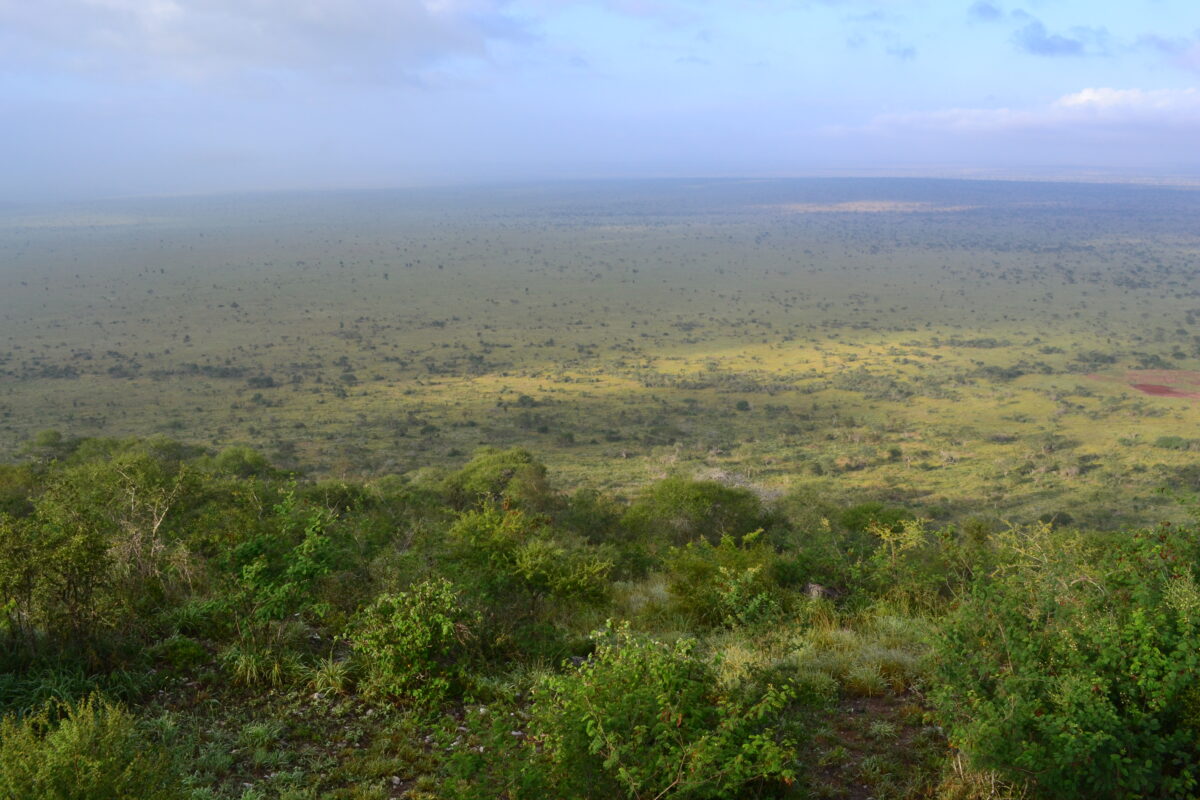Page snapshot: An introduction to temperate and tropical grass-dominated biomes and the threats that they currently face.
Topics covered on this page: What are grasslands?; Why are grasslands located where they are?; What are the threats to grasslands?; Resources.
Credits: Funded by the National Science Foundation. Any opinions, findings, and conclusions or recommendations expressed in this material are those of the author(s) and do not necessarily reflect the views of the National Science Foundation. Page by Naomi Schulberg (2023).
Updates: Page last updated August 31, 2023.
Image above: Savanna in the LUMO Community Wildlife Sanctuary, Kenya. Photo by Christopher T Cooper (Wikimedia Commons, Creative Commons Attribution 3.0 Unported license).
What are grasslands?
Ecosystems in which grass is the dominant vegetation (grasslands) are found on every continent besides Antarctica. They are found in areas that are both too dry to support forests and too wet to support deserts. They are maintained by various environmental factors, including grazing, fires, and seasonal drought.
Different names are used to describe grasslands in different regions. In North America, grasslands are called prairies. In South America, grasslands are referred to as pampas and cerrados. In Africa, they are savannas and veldts; in Australia, they are downs; and in Asia and Europe, they are steppes. Different grasslands support different amounts of non-grass vegetation. For example, savannas generally have scattered trees, whereas trees are rarer in steppes and prairies.
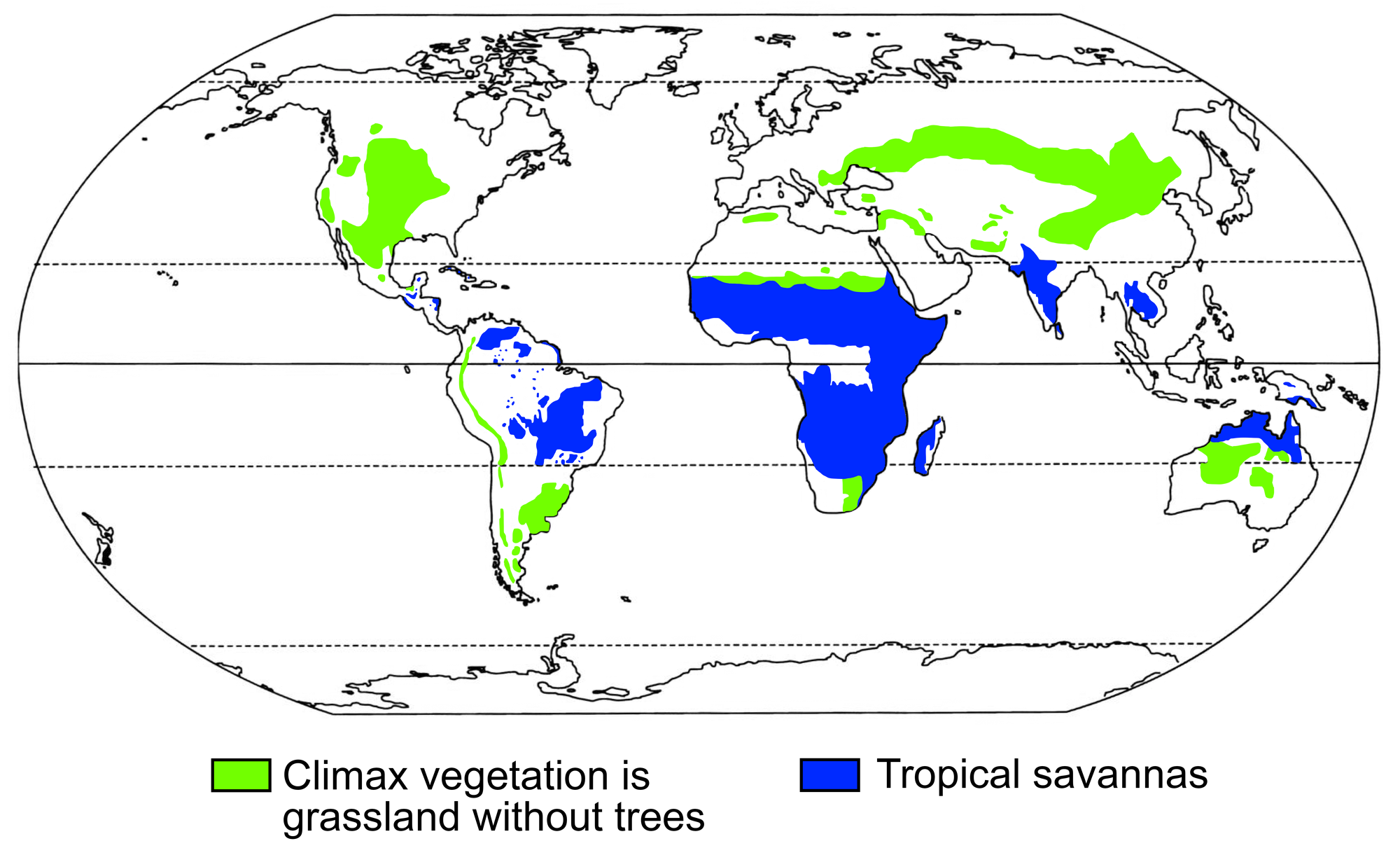
Modern distribution of grasslands (meaning biomes in which the climax vegetation is grass-dominated and lacks tress) and tropical savannas. Modified from figure 1 in Jacobs et al. (1999) Annals of the Missouri Botanical Garden 86: 590-643 (Biodiversity Heritage Library, Creative Commons-NonCommercial-ShareAlike 3.0 Unported license, image cropped, resized, reshaded and relabeled).
Grasslands can broadly be classified as temperate grasslands and tropical grasslands. Tropical grasslands are found between 30ºN and 30ºS of the equator. In tropical grasslands, temperatures do not drop below freezing, and there are distinct wet and dry seasons. Levels of rainfall range between 50 to 130 centimeters (about 20 to 51 inches) per year. Tropical grasslands include African and Australian tropical savannas, Indian savannas and grasslands, and South American cerrado.
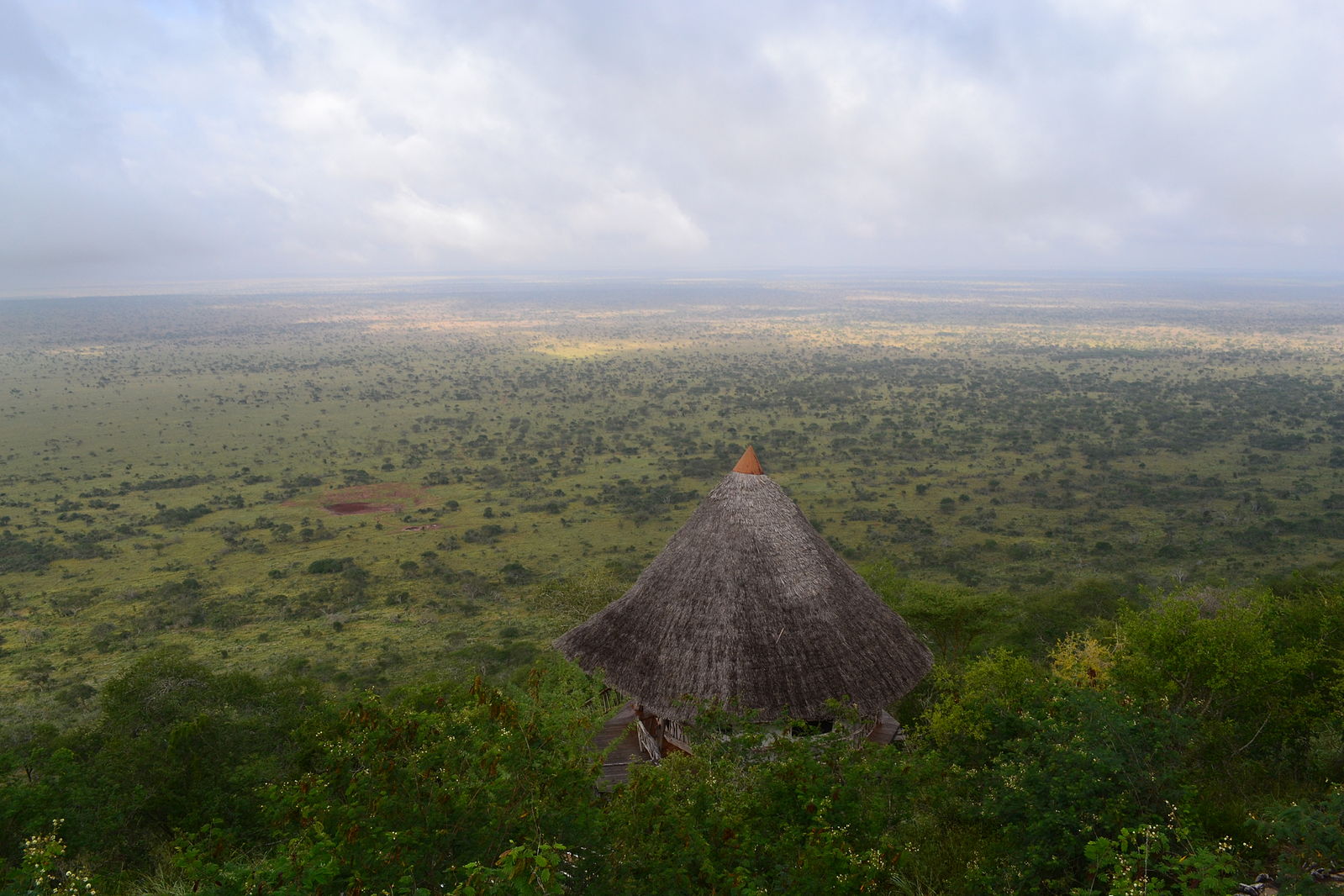
A hut in the LUMO Community Wildlife Sanctuary, a community-owned area of tropical savanna, in Kenya. Photo by Christopher T Cooper (Wikimedia Commons, Creative Commons Attribution 3.0 Unported license).
Temperate grasslands are found at mid-latitudes and are generally located within continental interiors. They have distinct warm and cold seasons, with temperatures dropping below freezing in the winter. Precipitation ranges between 25 to 75 centimeters (about 10 to 29.5 inches) per year. Temperate grasslands include North American prairies, Eurasian steppes, South American pampas and punas, South African veldts, Australian temperate savannas, and New Zealand tussocks.
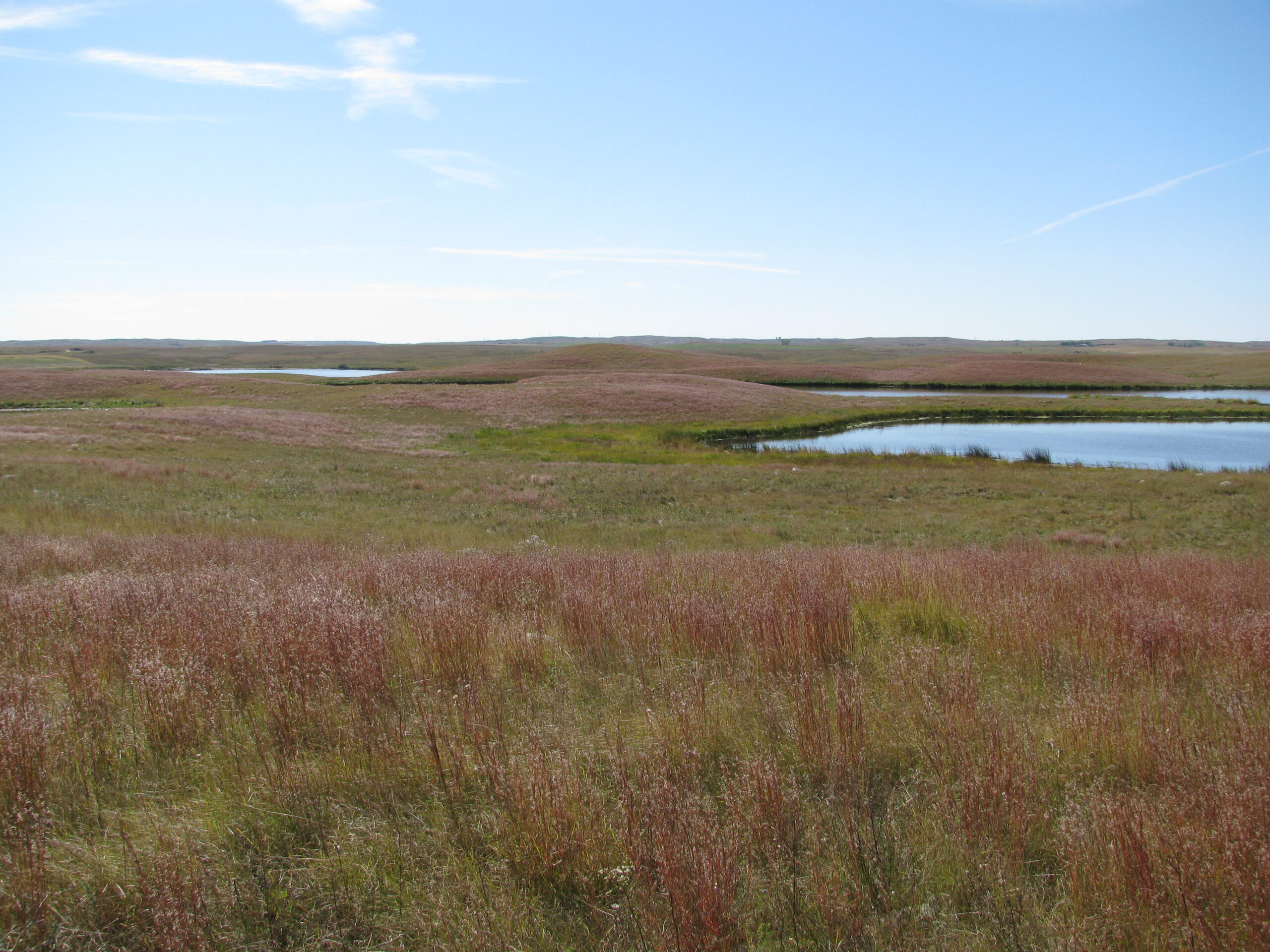
Mixed-grass prairie in the United States. Photo by the United States Forest Service Mountain-Prairie (flickr, Creative Commons Attribution 2.0 Generic license).
Grasslands support a unique variety of plants and animals and provide other ecosystem services. For example, grassland soils have a high capacity for absorbing water, and are therefore helpful in flood management. Additionally, grasses and other vegetation in grasslands stabilize the soil with their roots, preventing erosion and desertification. For humans, grasslands are also the source of economic revenue, typically when they are used for grazing or they are converted to raising crops.
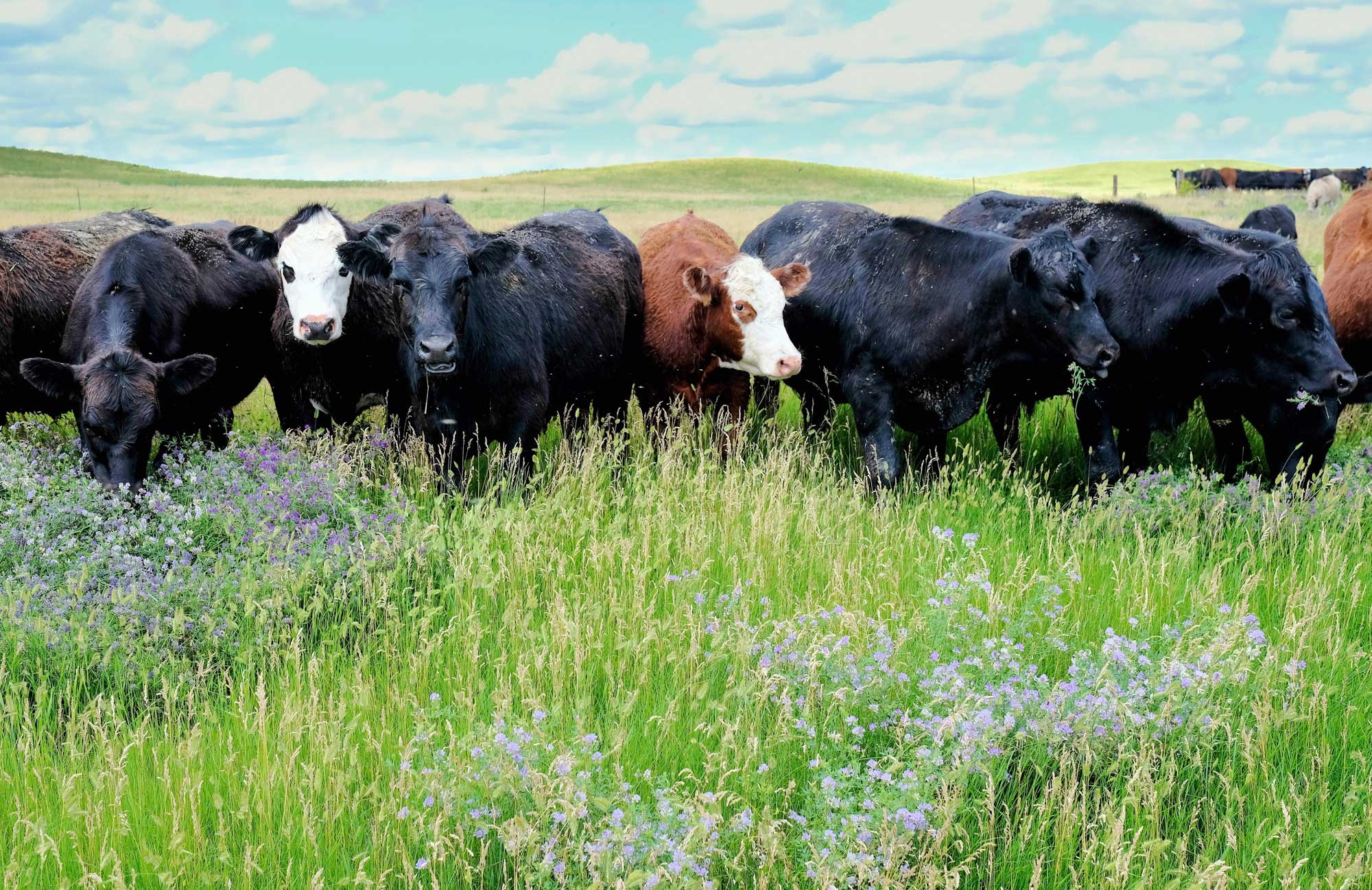
Cattle grazing on a prairie, South Dakota, U.S.A., 2018. Photo by Lars Plougmann (flickr, Creative Commons Attribution-ShareAlike 2.0 Generic license, image resized).
Why are grasslands located where they are?
Temperate grasslands
Temperate grasslands are located at mid-latitudes. They are found on every continent besides Antarctica. Temperate grasslands are often found in continental interiors and in other locations relatively far from a body of water (like an ocean) that can serve as a source of rain. Mountain ranges are also a major factor determining the locations of temperate grasslands. Many of the world’s temperate grasslands are located on the leeward side of mountain ranges and are formed by the rain shadow effect.
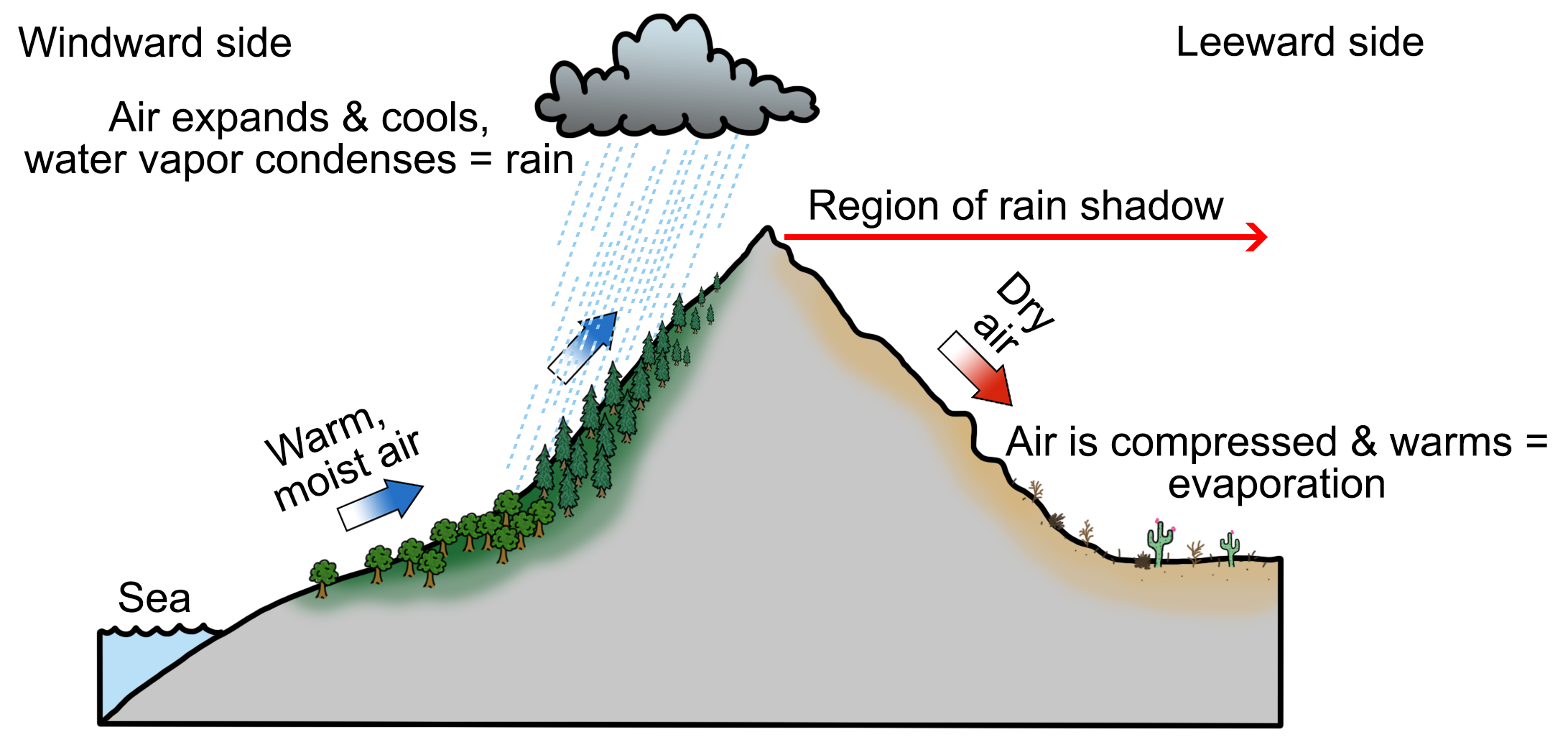
The rain shadow effect occurs when moisture-laden air rises up the windward side of a mountain, only to release this moisture as precipitation due to cooling and condensation. Once the air reaches the leeward side, it warms due to compression, promoting evaporation and a lack of precipitation. Diagram by Wade Greenberg-Brand, originally published in the Teacher Friendly Guide to Earth Science series, modified for Earth@Home.
Tropical grasslands
Tropical grasslands are located between 30ºN and 30ºS of the equator. They are found in South America, Africa, Asia, and Australia. The location of tropical grasslands, like other biomes in the tropics, are constrained and controlled by the interaction of trade winds at the intertropical convergence zone (ITCZ, located near the equator) and the effects of Hadley cells.
Hadley Cells are a global-scale tropical overturning circulation patterns that result in increasingly dry ecosystems moving from the equator to 30ºN and 30ºS. Solar heating causes air to rise at the ITCZ, where it condenses, causing precipitation (rainfall) to occur. Drier air then moves towards the poles and sinks at about 30ºN and 30ºS, creating deserts. The precipitation patterns created by Hadley Cells allow for tropical rainforests to occur at the equator and for deserts to occur at 30ºN and 30ºS. Tropical grasslands occur in the areas between the rainforests and deserts.
Differences in solar heating throughout the year cause the ITCZ to shift northwards and southwards seasonally. The ITCZ shifts northwards during the northern hemisphere summer and southwards during the northern hemisphere winter. The movement of the ITCZ results in seasonal wet and dry seasons in tropical grasslands. The wet season occurs when the area in question is close to the ITCZ, whereas the dry season occurs when the descending leg of the Hadley cell is overhead.
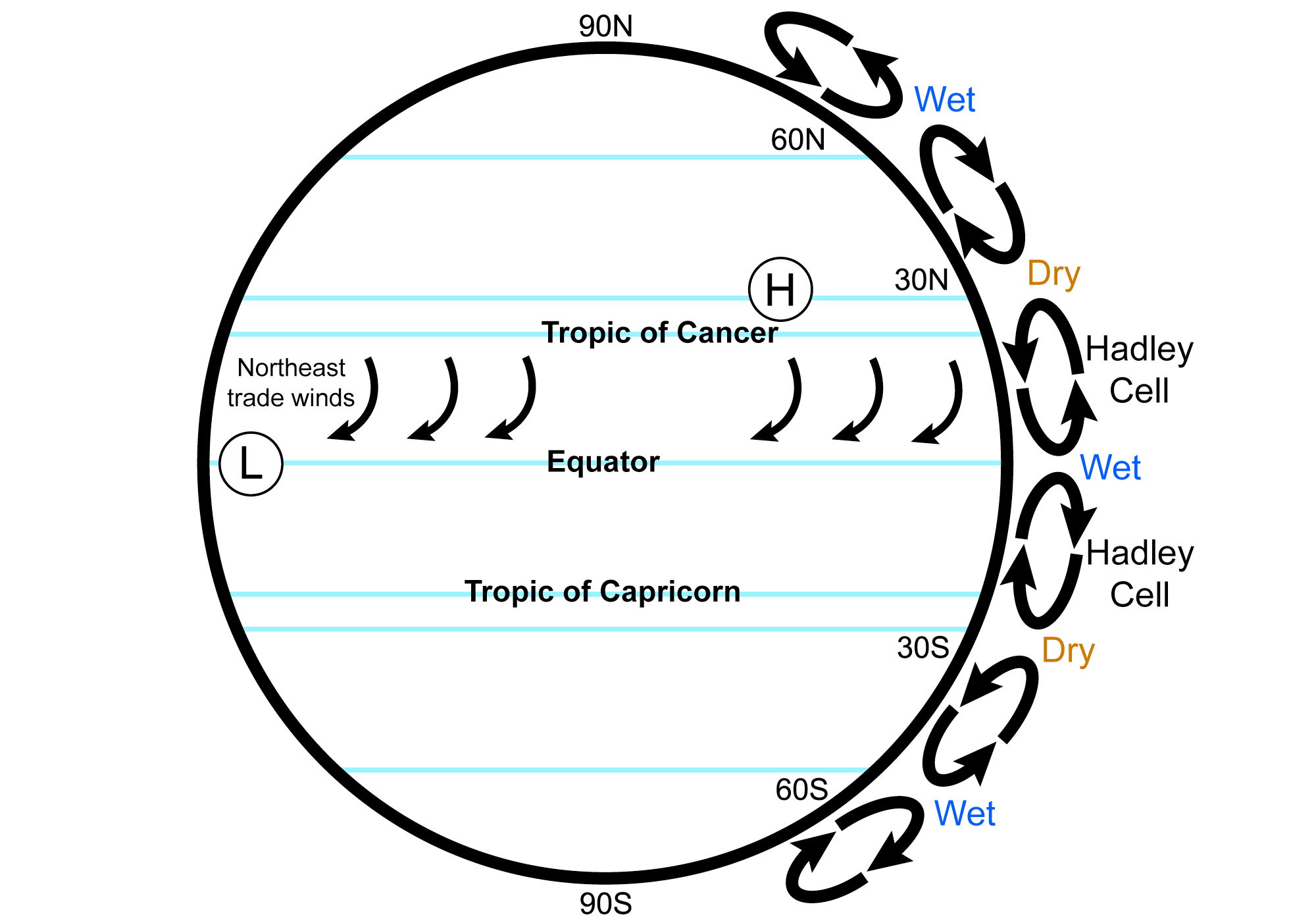
Hadley cells. Diagram redrawn by E. J. Hermsen from a diagram by Alexandra Moore that was originally published in The Teacher-Friendly Guide to the Earth Science of the Western US.
What are the threats to grasslands?
Grassland ecosystems currently face several threats, mostly due to human activities that alter grasslands directly, as well as from activities not directly altering grasslands (like burning fossil fuels), but that impact them nonetheless. Grasslands are often impacted by more than one threat simultaneously.
Agriculture
Both temperate and tropical grasslands are often used for agriculture, due to their fertile soils and the climates under which they thrive, which are suitable for farming or raising livestock. Cultivating crops requires removing native grasses from ecosystems. The crops that replace grasslands—which are often monocultures (fields of one species or even one variety of crop)—deplete the soils of nutrients. Pesticides may kill native insects, which can have negative impacts on native plants. Grazing agriculture is also common in both temperate and tropical grasslands, and overgrazing is an activity that threatens native grasses. Because grass roots absorb water and stabilize the soil, removing native grasses for planting crops or due to overgrazing can cause soil erosion and desertification.

An aerial photograph of the region near Arriba, Colorado, Great Plains of the United States, 2014. Much of the prairie in the United States has been converted to agricultural uses, as shown in this photo. Photo by Ken Lund (flickr, Creative Commons Attribution-ShareAlike 2.0 Generic license, image cropped and resized).
Invasive species
Invasive species are species of plants or animals that are not native to a region and that outcompete native species, with negative or harmful impacts. Invasive species of plants may damage grassland ecosystems. Many invasive species, such as buffelgrass (Cenchrus ciliaris) and cogongrass (Imperata cylindrica) in North America and prosopis (Prosopis juliflora, a type of shrub in the legume family/Fabaceae) in Africa and Asia, can outcompete and displace native grasses. Some invasive plants that occur in grasslands can also consume large quantities of groundwater, like prosopis and tamarisk (Tamarix, a shrub). Invasive plants that are fire adapted, like cogongrass, may fuel destructive wildfires, which can create a feedback mechanism that reinforces their dominance.

Prosopis (Prosopis juliflora), a shrub that is native to the Americas and invasive in Asia. This prosopis was photographed in Thane, India. Photo by Dinesh Valke (flickr, Creative Commons Attribution-Share Alike 2.0 Generic license).
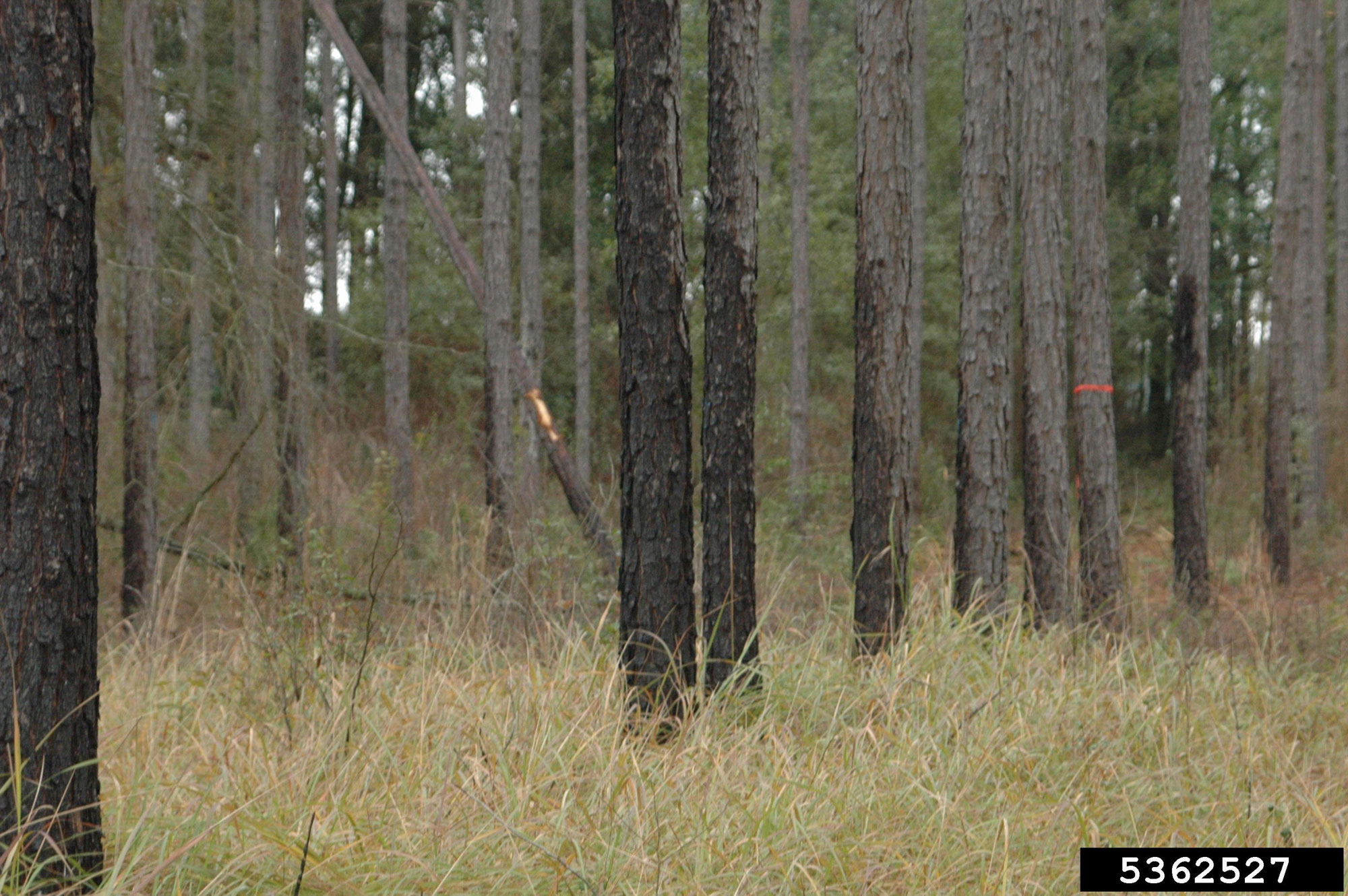
Cogongrass infestation. Original caption: "Burn marks on trees from extreme heat produced by flames fueled by cogongrass." Photo by Carey Minteer, University of Florida (Bugwood.org photo UGA536527, Creative Commons Attribution 3.0 United States license).
Fire suppression
Fire suppression is another activity which can damage grassland ecosystems. Grasslands are maintained by periodic fires, and without fires, forests or shrublands may grow in their place. Fire suppression due to human activity is thus reducing grassland habitats.
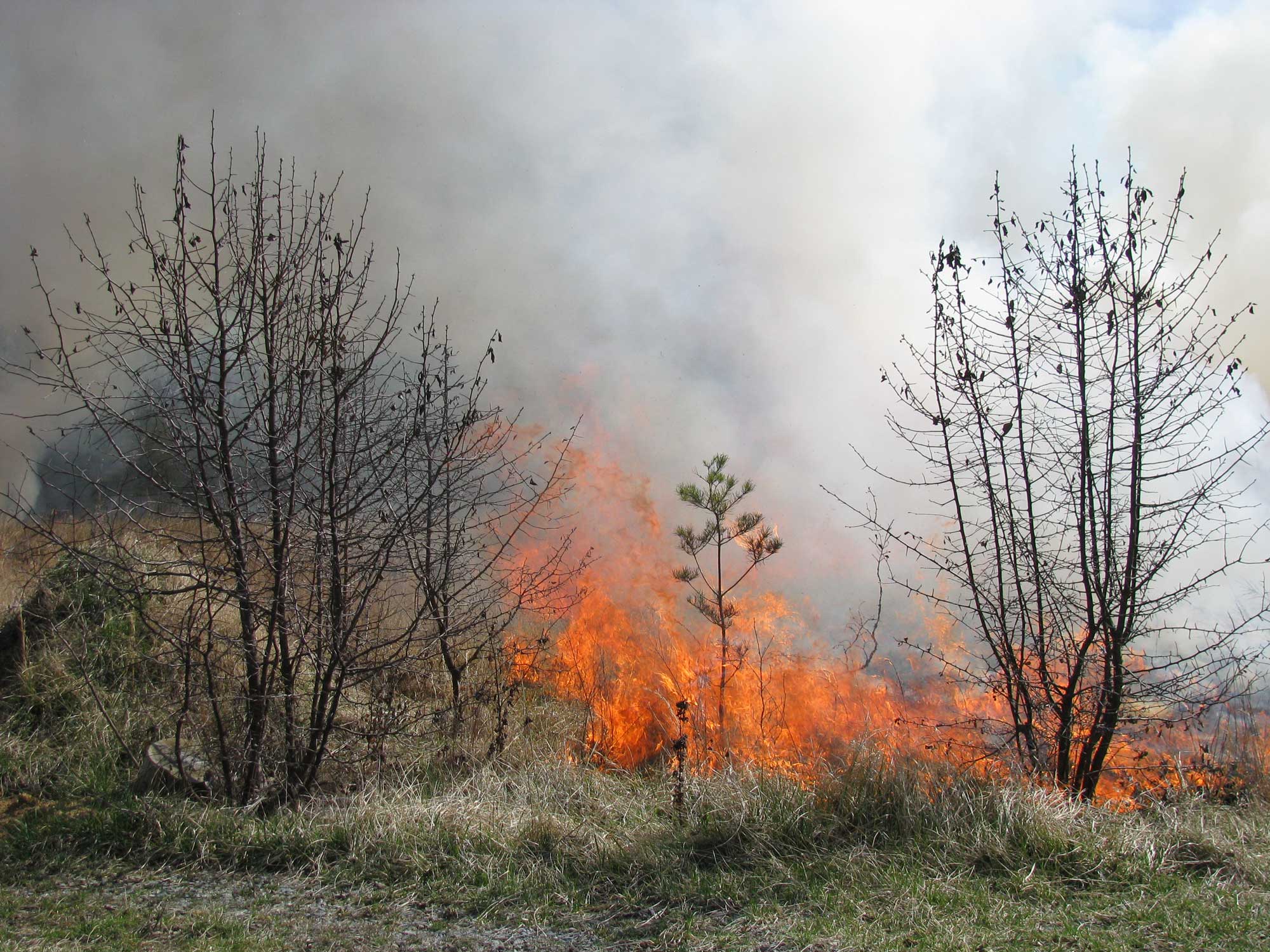
Original caption: "A controlled burn consumes small trees and shrubs encroaching on a grassland field. The burn, at Patuxent Research Refuge, was to maintain native grasslands, remove woody vegetation, and control invasive species such as Korean Lespedeza." Maryland, U.S.A., 2012. Photo by Sandy Spencer/USFWS (U.S. Fish and Wildlife Service on flickr, public domain).
Climate change
Grasslands are threatened by climate change. Most projections indicate that extended periods of drought are likely to become more common in many of the world’s grassland ecosystems, which will likely threaten native species of plants and animals. Desertification is also a likely effect of climate change in some grasslands. The subsaharan savannas in Africa, for example, are at risk of desertification as the areas around the Sahara Desert continue to become drier.
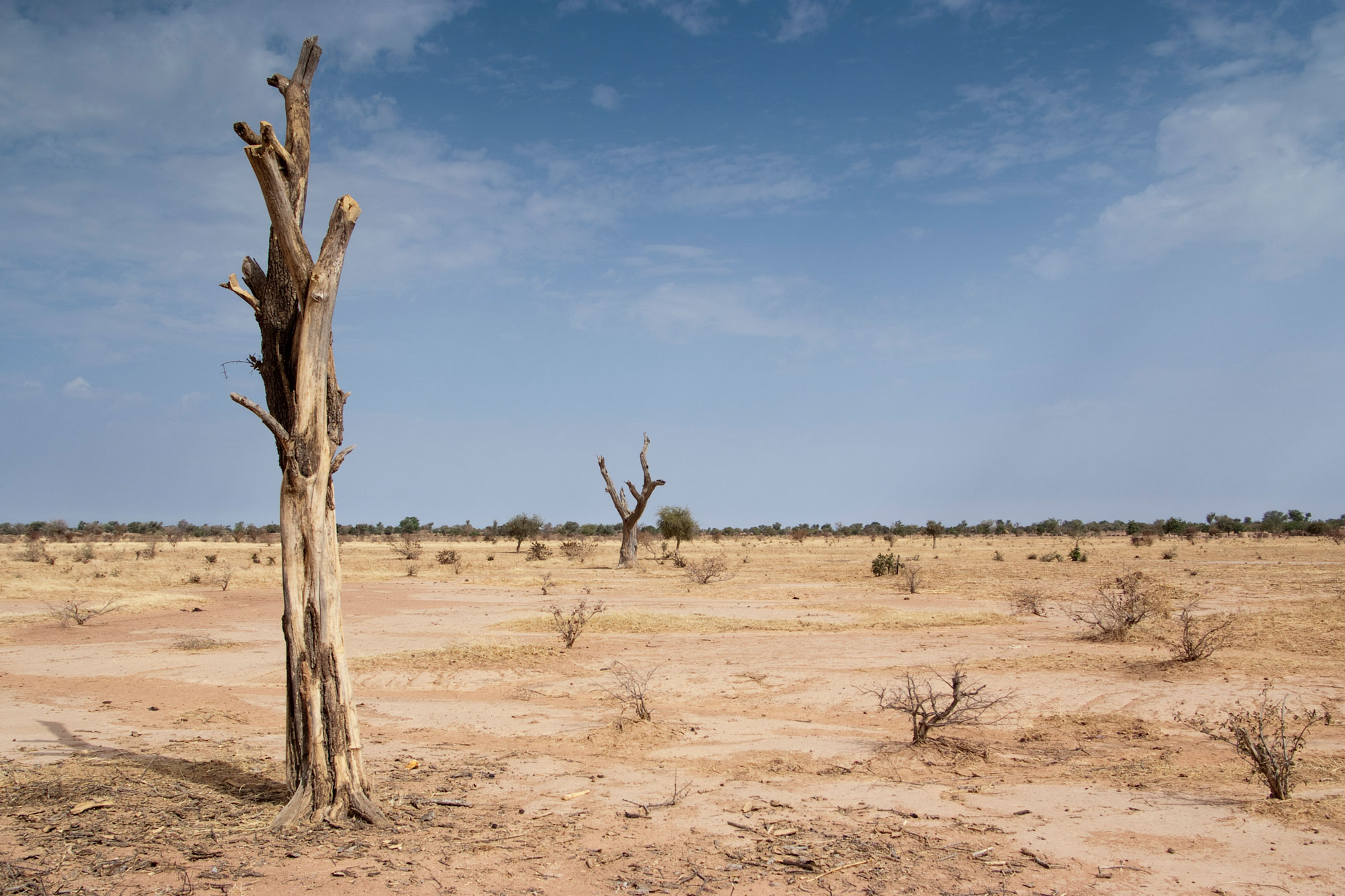
Desertification near the southwestern margin of the Sahara Desert in Burkina Faso, 2011. In this case, cutting of trees probably influenced drying of the landscape; often, desertification may have multiple drivers. Photo by TREEAID (flickr, Creative Commons Attribution 2.0 Generic license, image resized).
Resources
Websites
Ecosystem services from national grasslands (U.S. Forest Service): https://www.fs.usda.gov/managing-land/national-forests-grasslands/national-grasslands/ecoservices
Grassland (NASA Earth Observatory): https://earthobservatory.nasa.gov/biome/biograssland.php
Rain shadow (National Geographic Education): https://education.nationalgeographic.org/resource/rain-shadow/
Ten reasons for preserving grasslands (Swedish University of Agricultural Sciences News): https://www.slu.se/en/ew-news/2019/2/grasmarker/



